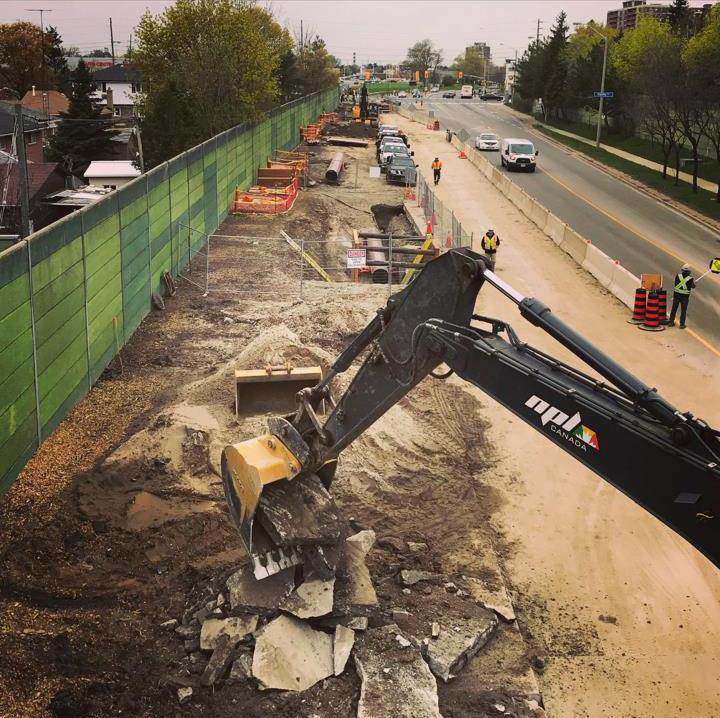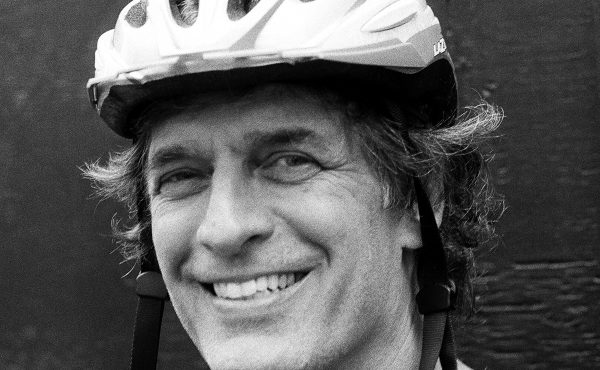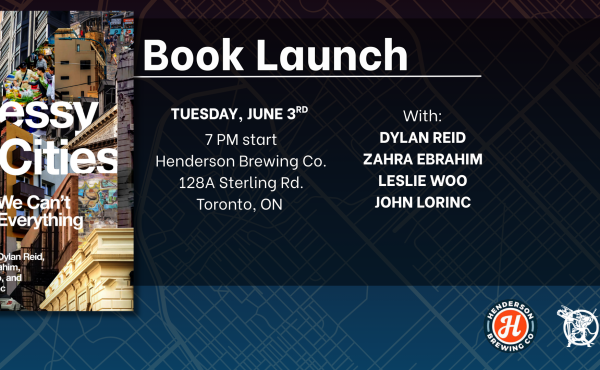In the next few days, work crews will begin tearing up the intersection of Finch Ave. West and Martin Grove — deep in the heart of Ford Nation – in order to shift some buried Enbridge gas lines.
This isn’t a City project; however. It’s the latest chapter of the Finch West LRT construction project, which has been in the ground for many months, with a great deal of work underway. As of late January, 2018, in fact, Metrolinx had spent $236.3 million on the line, or approximately a fifth of the 2010 budget of $1.2 billion, according to agency spokesperson Anne Marie Aikins.
Remember this non-trivial figure (roughly equivalent to a 10% property tax hike) when Progressive Conservative leader Doug Ford begins yelling about infrastructure and transit in Greater Toronto. This seemingly inevitable gong-show will rumble through the election campaign, and almost certainly feature threats to wrest the subway system away from the City of Toronto as well as ice or cancel approved LRT projects and the Relief Line, that subway tailor-made, we’ll be assured, for Toronto’s champagne-swilling elites.
Kathleen Wynne’s Liberals clearly sought to fire a shot across Ford’s bow just days after his convention victory with what was described as an unexpected move: almost matching a federal infrastructure grant of $4.89 billion with a $4.04 billion contribution from provincial infrastructure budgets. As the Toronto Star reported, the money will help pay for the rest of the Scarborough subway extension, as well as Smart Track, the Relief Line, and LRTs along Eglinton East and Queen’s Quay.
The bilateral agreement signed March 14 included all sorts of previously announced big dollar pledges, including the flood protection berm for the Portlands and that $660 million contribution to the Scarborough subway that dates back to the days when Stephen Harper and Rob Ford cut deals in a row boat on Meech Lake. The additional funding isn’t sufficient to complete the Relief Line.
Ford, of course, came barreling out the gate promising to cut $6 billion of provincial spending – 4% — and cancel both the carbon pricing system, that will bring in $1.8 billion for 2017-2018, and the foreign buyers tax. (His campaign didn’t respond to Spacing‘s questions about his transit plans.)
Labour economist Jim Stanford has pointed out in The Globe and Mail that the Tories’ Fordonomics will leave a $10 billion funding gap that will likely lead to pressure for steeper cuts. But in the debates about these promises (featuring Ford’s vacuous rhetoric about no job losses), it will be really important to remember that vast chunks of the provincial budget are third rail categories: 40% for health, 26% for education, 11% for children’s and social services, 8% for interest, 3% for justice.
In other words, the bulk of the cuts will be focused on the remaining 13%, or about $19.3 billion, almost all of which is infrastructure. What’s more, transit accounted for over $7 billion in the Liberals’ spending plan for 2017-2018. (The balance are hospitals, courthouses, highways, etc.)
Point is, when Ford goes shopping for cuts, he’s going to come after the transit projects he hates.
His views on LRTs are abundantly well documented from the dark days when the brothers Ford bellowed ceaselessly about LRTs. The detail to watch today is whether Ford will try to cancel the ones on the books (as Mike Harris did with the Eglinton subway) in order to win votes among those GTA residents, both in the 416 and the 905, who have conditioned, from years of misinformation, to dislike a globally used transit technology that’s never been deployed here.
If Ford does pull the plug, as brother Rob famously attempted to on day one of his mayoralty, everyone should know that he’ll be setting fire to a whole lot of taxpayer dollars. According to Metrolinx, the province has budgeted $10 billion for the five big Greater Toronto LRT lines (Eglinton, Finch, Sheppard, Hurontario and Hamilton), of which $4.2 billion has been spent. Most, of course, has gone to the Eglinton Crosstown.
I’d say there’s virtually zero chance that a Ford government would stop that project because the sunk costs are so great, the cancelation penalties so steep.

But will he have the nerve to order Metrolinx to down tools on Finch? Unlikely, but not impossible, especially if its most madcap opponent, Giorgio Mammolitti, ends up winning a place in Ford’s caucus (The councillor appears to be tangled up in a smelly land deal that’s become the subject of an OPP investigation).
A total of $183 million has been sunk into projects in Hamilton and along Hurontario. Is that outlay enough to make Ford think twice about wasting so much money, or will he just pledge to rip up the whole thing, promising instead a subway in every pot.
As for the Sheppard LRT, the most star-crossed of all Toronto transit projects, I fear it is surely a dead letter in a Ford government, and would cost nothing to scotch (no money will be spent until Finch is finished). Same with Queen’s Quay and probably Eglinton East, despite local support for the latter.
Which brings me to the Relief Line. According to agency spokesperson Brad Ross, the TTC has spent or signed contracts worth a total of $46.5 million, while Metrolinx has budgeted $150 million for the Relief Line North (up to Don Mills/Crosstown).
Compared to the overall estimated cost of $6.8 billion (but likely much more), the amount spent on the Relief Line to date is scarcely more than a rounding error. My prediction: he’ll dare both the provincial and federal Liberals to cross him by pledging to direct the bulk of those new bilateral transit dollars to extend the Yonge subway to Richmond Hill — a sure-fire vote getter in the 905, despite the idiocy of pouring ever more riders into a funnel that can no longer hold them all.
From bitter experience, Toronto voters know that Ford will blow all sorts of smoke about subways – that the private sector can build and operate them at a profit, and that [insert desired constituency’s name here] deserves them to atone for some illusory past wrong.
The bloviating had clear limits in the realm of municipal politics. However, his access to the provincial domain — combined with the necessity of winning over 905ers – utterly alters the calculus, especially if Ford revives the Hudak/Brown pledge to somehow upload the TTC’s subway network.
Armed with a majority, he could take that step with the stroke of a Trumpian pen, at which point we can all wave a tearful goodbye to the prospect of ever building a rational and safe transit network in a city that has clearly outgrown its current system. That’s precisely what’s at stake when Ford promises his seemingly painless 4% spending cut.






15 comments
Doug Ford has shown himself, repeatedly, to be completely ignorant when it comes to anything relating to Public Transit. As recently as 2 months ago, when he was “in” the race for Mayor of Toronto, he was totally and factually on the WRONG side of the King Street Pilot project. Toronto, and even the greater GTA are still trying to recover from the damage done to overall transit development at the hands of former Mayor Rob Ford, and then city of Toronto Councillor Doug Ford. If voters in the GTA care about having better Public Transit, and relieving the crippling and very costly traffic congestion grid-lock that plagues the region, Doug Ford and the PC Party would be VERY poor/bad choices in the upcoming Ontario Provincial Election.
I also worry that legislation will be passed banning Ontario cities from making transit-priority measures on their own streets as a fake effort to “get traffic moving.” And thereby also killing the King Pilot.
Current government should commit a a poison pill for DRL funding. Set aside 2 billion to only be spent and no attention to any lines that add traffic from Bathurst to Cowell, union to eglintons
Ford’s “Efficiencies” sounds a lot like Mike Harris’ “Common Sense Revolution” and we all know how that worked out.
In honour of DoFo me an my buds are organizing a campaign-style event at #JamesGardens we call #DougFordBuyIn. Cuz I’m buyin’ what he’s sellin’ Speakers will be blasting #humblepie S74n2YF7WOI #blacklebanese @80sDougFord
Beware of Doug.
The ON PC Party has always hated Toronto and has always hated public transit; just look at what Mike Harris did, we’re still recovering from that disaster. A vote for the PCs is a vote against Toronto.
Toronto is at a critical point in public transit development, particularly in regards to the DRL and we can’t afford the incompetence and deceit of the Ford Conservatives.
Perhaps it’s time to consider Toronto applying for provincial status because Ontario is dragging Toronto down with these pig-headed, incompetent Conservative governments.
@Richard. The Ontario PCs have *not* always hated Toronto; quite the contrary. Under Bill Davis, Tory governments at Queen’s Park built subways, created a cost-sharing formula for transit that lasted for over two decades, funded social housing, expanded schools and universities, etc. Harris and post-Harris Tories, however, became increasingly dismissive of the role of the city in the life of the province, which is why they’ve been parked for so long on the opposition benches. In the almost 33 years since the Big Blue machine lost control of Queen’s Park, the Tories have been in government for only eight (1995-2003). It shouldn’t take a genius to figure out what’s wrong.
Transit is evolving dramatically, especially now with self-driving cars (although on hold temporarily) along with flying cars, and monorail systems. Governments need to slow down with tunnels and do one project at a time, at a billion dollars each, and balance the needs of a large percentage of low to no income people, looking for affordable housing instead. Many steal bikes and e-bikes, and chop them up, so the utopian city is far off. Also, there is a real problem using available costly real estate with sidewalks and bike lanes. I think these should be combined to free up vehicular space, along with more angled parking.
While some of the large transit projects are Suspect to Stupid (compared to political will on surface routes), Fordwards was backwards, and it would be again.
Not sure why we are already crying about what Ford “might” do.
Metrolinx has gotten very little of the remnants of Transit City going. Just starting on the Finch thing now, what, 8 years after Miller left office. Zero lines finished, two under construction, one just barely.
Dalton wilted or buckled to the first Ford. Not much leadership there.
A P3 model that has received little scrutiny.
Very expensive proposals for Go electrification (all the way to Barrie apparently).
A subway extension to Greg Sorbara’s riding.
A long over schedule reno of Union Station.
An over-priced Union Pearson line.
A run-amuck GTAA board proposal for Union Station West.
Ornge (people died), EHealth, GasPlants, Sudbury by-election scandals.
(you could probably build an LRT line for what we blew on the Gas Plant thing)
401 freeway expansion continues merrily to Milton.
Toronto, the GTA, and Ontario have a lot of problems … lotsa blame to go around
The Grand Compromise:
-drop the Scarboro subway
-drop the relief line
-drop SmartTrack
-Metrolinx/Go already owns the rail tracks North-South through Scarboro (Stouffville line)
-Metrolinx already has grandiose electrifcation plans
-the route of the GO Lakeshore east isn’t a heck of a lot different from the relief line, already owned.
-re-target Metrolinx to electrify the Scarboro line *first*
-re-target Metrolinx to electrify a small portion of the Lakeshore East line *first*
-re-target Metrlolinx to move to smaller train/more frequent service
-add additional stations in east T.O.
-essentially, convert part of the Stouffville line and Lakeshore East line to an above-ground “subway”
+Scarboro get’s its promised line, and more
+downtown gets its relief line, earlier, cheaper
+Puts Ford I’s legacy to rest
+Gives Metrolinx something useful to do
+doing a smaller electrification let’s GO build experience
+looks a bit like SmartTrack, so Mayor Tory is satisified, pledge fulfilled
@Paul McCutcheon
ROB FORD AND DOUG FORD are almost 100% to blame for the lack of progress when it comes to transit building. had they not canceled transit city we would have a lot more right now.
The following routes were to be constructed and opened by 2020.
Sheppard East LRT
Etobicoke–Finch West LRT
Eglinton Crosstown LRT
According to the Star, the originally announced date for Finch was **2013** … not 2020
The “new” completion date is 2023 … 10 years late
(Ford was around for how long? two years?)
https://www.thestar.com/news/gta/transportation/2018/04/19/finch-lrt-delayed-another-year.html
Metrolinx has spent $228 million already, with maybe one spade in the ground.
Yes, Ford I introduced delay … but McG cut back on the original TransitCity, then wilted when Ford came along. The way I understand it is the province and city had an agreement on transit city, the province could have stuck to its guns longer; it was a joint decision to abandon transit city.
I think a lot of transit advocates get frustrated and simply want to “get something (!anything!) built”. They don’t want to criticize or examine Metrolinx very closely, for fear of nothing getting done.
If you trust our transit planning, then you might ponder why Mississauga built a busway with grade separation at intersection for East-West transit, but an LRT with at-grade intersections for North-South. Does it really make sense?
My main point was that the current government and Metrolinx have not been especially effective at delivering transit.
1) “The Best is the Enemy of the Good”
*Everybody can see that a subway is the “best” performing system (ignoring cost) – fast trips, fast boarding, short wait times, out of the elements, doesn’t mess up the street.
*The LRT advocates have a hard time explaining the “good” – reasonable cost, fast-ish trips, fast boarding, short wait times, “bang for the buck”. They are shading the downsides (loss of traffic lane, loss of left turn lanes, how to co-ordinate traffic lights, what to do if an accident blocks the tracks, P3, appearance of overhead wires and so forth). Generally advocates seem to be preaching to the choir, rather than selling the compromise.
2) There is a lot of doubt about LRT:
a) You can see in Hamilton more people are aware of the LRT project, the less they like it.
https://www.thespec.com/news-story/8575101-hamilton-least-supportive-lrt-city-survey/
b) Both Brampton and Port Credit rejected LRT in the crowded downtown areas.
So it isn’t just a “Rob Ford” thing in the past … and it won’t necessarily be a “Doug Ford” thing in the future.
3) Kitchener-Waterloo and Ottawa seemed to have steamed ahead on LRT without Metrolinx… so maybe the messaging/leadership problem is at Metrolinx?
4) Personally I am mildly in favor of LRTs, but I haven’t drank the Koolaid yet. I was very disappointed with McG’s lack of leadership. And if you think Wynne and Tory are doing a good job on the Scarboro subway, think again.